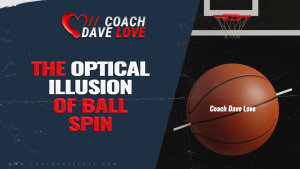I don’t teach players to get their feet shoulder width apart. In fact, I LOATH the fact that we teach players to get their feet “shoulder width” apart.
Ok, now let me dial it back and explain. I do agree with the general principle that our feet should be that wide. In fact, I probably teach a little wider apart than most. The part of “shoulder width” that I dislike is the fact that we picked our shoulders as the reference point.
I’ll ask players in every clinic to look at their shoulders and judge how wide they are. Every player looks down, moves their head from side to side, then stares blankly ahead. The reality is, “shoulder width” apart is something we all started saying as coaches, and never looked at to say “wait a minute, I can’t even see my own shoulders. Why am I using that as the reference point?”
The reality is that when we talk about being ‘shoulder width apart” what were are generally talking about is the players feet. When they look down at their feet, they can see their hips, and our hips are about the same width as our shoulders. So I talk about getting feet “hip width apart”.
The next part of the equation is “what part of our feet should be the width of our hips apart?” There is a big difference in stability when the outsides of players feet are a certain width, versus the insides of their feet being that same width. Personally, I encourage players to try to get the insides of their feet the same width as their hips. In other words, I want their feet to be wide enough that they could sit down between their shoes and their hips not touch the sides of their shoes.
That might be a little wider than most teach, but there is are reasons for it.
First, you never quite get what you want when a player isn’t mindful. So to combat this, I might teach a player a little wider than I actually hope for. The reality is, having too much stability isn’t a bad thing, and to a certain extent, the wider your base the more stabile you will be.
Second, I want to prepare players for the worst case scenario, not the best case. If I prepare players to be able to be on balance in the most difficult circumstances, then they are going to be able to do it in the more simple situations. But if I build habits that will work in the simple situations, those same habits might not help in the heat of a game.
Here is an example. People will say “look at Player X when they are shooting free throws, they have their feet narrow, so it must be an ok thing to do.” The reality is, when you are shooting free throws you don’t generate much negative energy that you need to stop. You are stationary. So your stability isn’t that big of an issue. If I teach a player to get their feet wide enough to keep them stabile when there isn’t no negative energy being generated, what are they going to do when there is a lot of negative energy? Their habits won’t help them in that setting.
Lastly, if you look at every athletic endeavour, you will find examples of players being dynamic and athletic and stable in a wider foot position. In clinics I’ll ask players to pretend they are in the back row of a volleyball game with someone spiking the ball at them. They get low and wide. I ask them to pretend they are a goalie in a soccer game. They get low and wide. A short stop in baseball, low and wide. That is a strong, stable, athletic body position, and that is the body position we need to be in when we shoot the basketball.
Your foot position on your shot isn’t so much to help with your shot, it is to help you transition from non-shooting movements to a shooting movement while maintaining control of your body.



